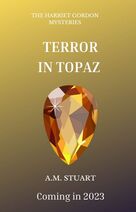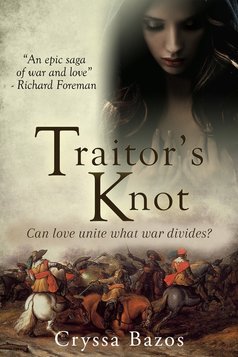
- BY THE SWORD
- THE KING'S MAN
- EXILE'S RETURN
Alison
Notes from Alison's Typewriter is the place to go for all Alison's news and updates on books... exclusive content, contests and more!
 I have some exciting news about the three GUARDIANS OF THE CROWN BOOKS but for the moment they will be temporarily unavailable.
Alison 
If you have enjoyed my Guardians of the Crown trilogy (out now as a boxed set... click HERE) set in the years of the 'Interregnum" 1650-1660, then you are going to love Traitor's Knot by Cryssa Bazos.
Many former royalists were forced to take the road as highwaymen (James Hind being a great example) and it's against this background that Cryssa has set this story that begins in 1650. Highwaymen, royalists... what's not to love! (And I have a serious case of cover envy...) As I do with all my guests I asked Cryssa to share an interesting snippet she found in research and here she is to talk about literacy and news... Spreading the news in the 17th Century...
People in 17th century England weren’t as illiterate as you would expect. By the end of the century, it was thought that just under half of all men could read and over a quarter of women. Amongst the middle class, the majority was literate. This is the century when diary writing became a fad, and we’re still benefiting from their self-expression. But these estimates might not reflect what was really happening on the ground.
The significant increase in literacy over the previous century correlates with the explosion of printed material that floods the market in the mid-century. Broadsheets, newspapers and ballad sheets were all being turned out in record numbers. In fact the first newspapers, (e.g. Mercurius Politicus), were propaganda machines that helped fuel the civil war. Royalist and Roundhead each had their own publications pushing their agenda and that shaped public opinion. Really no different than today. The explosion in print occurred not only because of the advances in print technology (cheaper, faster presses), but an increased consumer demand for it. Not just any consumer— looking at what was being printed, one could see that the lower to middling classes were now the new consumer. For example, following the Battle of Worcester the authorities captured the famous highwayman Captain Hind and accused him of helping Charles II escape. Leading up to his trial, Londoners were snapping up stories about him faster than publishers could produce them. One publication, the English Gusman, depicted Hind as a Robin Hood figure whose exploits could appeal to the common man. Since the lower classes were the target market for these hot new publications, it’s a safe bet that more of them could read or had access to those who could read it for them. About TRAITOR'S KNOT
England 1650: Civil War has given way to an uneasy peace in the year since Parliament executed King Charles I.
Royalist officer James Hart refuses to accept the tyranny of the new government, and to raise funds for the restoration of the king’s son, he takes to the road as a highwayman. Elizabeth Seton has long been shunned for being a traitor’s daughter. In the midst of the new order, she risks her life by sheltering fugitives from Parliament in a garrison town. But her attempts to rebuild her life are threatened, first by her own sense of injustice, then by falling in love with the dashing Hart. The lovers’ loyalty is tested through war, defeat and separation. James must fight his way back to the woman he loves, while Elizabeth will do anything to save him, even if it means sacrificing herself. Traitor's Knot is a sweeping tale of love and conflicted loyalties set against the turmoil of the English Civil War.
Read an excerpt...
Elizabeth Seton browsed the household stalls, strolling at her leisure. James walked towards her, his eyes fixed firmly on the prize. She hovered over a collection of linens, and her fingers brushed over the cloths, but she did not linger beyond a curious moment. James kept a discreet distance, ever narrowing the gap. One slim hand held her skirts, raising them slightly to avoid a muddy puddle before she continued on her way.
He halted his progress when she became rooted at the bookseller’s. While fancy ribbons and laces had not attracted her interest, a stack of pamphlets and chapbooks made the difference. She struck up a conversation with the bookseller, laughing at something he said. James rubbed his chin, engrossed. An unusual maid, he thought, and drew closer. Leaning over the small collection, her head tilted to peer at the titles. Hair secured in a sedate knot, a wayward tendril escaped its constraint. The wind lifted and teased the stray lock, contrasting to the paleness of her nape. James fought the urge to reach out and twist the strand in his fingers. He bent forward and addressed her in a low tone, “Are you looking to improve your mind, or to seek instruction?” Elizabeth started in surprise. Her eyes widened, and for the first time, he realised how blue they were. Almost immediately they narrowed, as though she wasn’t sure how to respond to his boldness. He knew he was being forward, but he had never won a thing without pressing his advantage. “I am looking for a book on good manners, sir. I would not expect you to recommend one.” Meet Cryssa Bazos..
Cryssa Bazos is an award winning historical fiction author and 17th century enthusiast with an oddly paired interest in both the English Civil War and romantic fiction. Her absolute favourite books are romantic adventures steeped in history. Traitor's Knot, her debut novel published by Endeavour Press, placed 3rd in the 2016 Romance for the Ages Ancient/Medieval/Renaissance) contest.
Connect with Cryssa through:
Facebook: (https://www.facebook.com/cbazos/) Twitter (@cryssabazos) Instagram: cryssabazos https://www.instagram.com/cryssabazos/ Website: https://cryssabazos.com |
Alison StuartAlison writes historical romances and short stories set in England and Australia and across different periods of history. Archives
January 2023
Categories
All
|